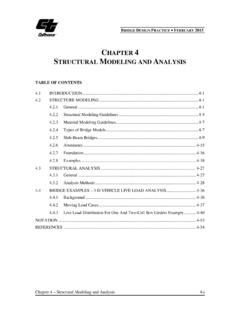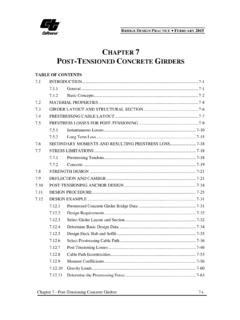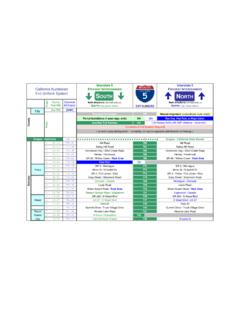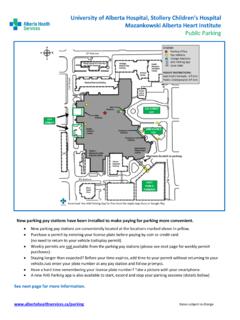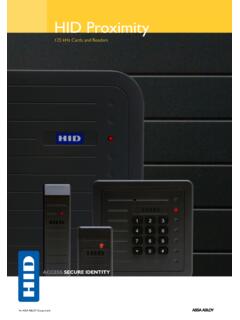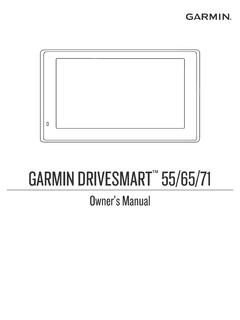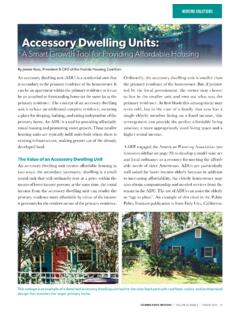Transcription of Permanent Pedestrian Facilities ADA Compliance Handbook
1 Permanent Pedestrian Facilities ADA Compliance Handbook State of California Department of Transportation Division of Construction March 2018 Permanent Pedestrian Facilities ADA Compliance Handbook State of California Department of Transportation Division of Construction Prepared by Office of Contract Administration 1120 N Street, MS 44 Sacramento, CA 95814 MARCH 2018 Cover images: Curb Ramp Inspection Forms Copyright 2018 California Department of Transportation All Rights Reserved. (No part of this manual may be reproduced in any form or by any electronic or mechanical means including information storage and retrieval systems without the permission in writing from the California Department of Transportation). About the Permanent Pedestrian Facilities ADA Compliance Handbook This Handbook provides information for inspection of Permanent Pedestrian Facilities for Compliance with the Americans with Disabilities Act (ADA) standards based primarily on Design Information Bulletin (DIB) 82-06, Pedestrian Accessibility Guidelines for Highway Projects, for the California Department of Transportation (Caltrans).
2 Caltrans Division of Construction will revise and update this manual to keep current with revisions to DIB, other standards and guidance concerning ADA Compliance . Employees should forward suggestions for improving this manual, to the office responsible for maintaining this document, which can be found on the Division of Construction website, at: Responsible office: HQ Office of Contract Administration Division of Construction 1120 N Street, MS 44 Sacramento, CA 95814 Permanent Pedestrian Facilities ADA Compliance Handbook Table of Contents Standard Measurement Tools and Practices ..6 Documentation and Checklist Usage ..8 General Sidewalk / Path of Travel Checklist ..8 Curb Ramp Detectable Warning Surface Checklist ..19 Ramps, Stairs, Handrails, and Guards Checklist.
3 24 Ramps: ..24 Stairs: ..27 Handrails:..28 Guards:..30 Pedestrian Push Buttons and Accessible Pedestrian Signals Checklist ..31 Parking Facilities ..34 General:..34 Off-Street Parking:..34 On-Street Parking: ..40 Special Bus Stops: ..42 Railroads: ..42 Exhibits: ..42 Special Pre/Post Construction Surveys:..43 Intersections Without Yield or Stop Control: ..43 California Department of Transportation Division of Construction Page 4 March 2018 Permanent Pedestrian Facilities ADA Compliance Handbook Introduction The California Department of Transportation (Caltrans) developed this Handbook for construction field staff who inspect Permanent Pedestrian Facilities in consideration of American with Disabilities Act (ADA) requirements. Not unlike other Facilities on Caltrans projects, staff help ensure the constructed Facilities comply with the contractual requirements of the plans and specifications.
4 However, unlike other Facilities , there are absolute ADA Compliance measurement requirements for Permanent Pedestrian facility features. Designers are to provide project details for these Facilities that comply with ADA requirements pursuant to Design Information Bulletin (DIB) 82-06, Pedestrian Accessibility Guidelines for Highway Projects, while accommodating project constraints. While field staff are not expected to be experts in ADA codes and regulations, there is a need to have a basic understanding of ADA Compliance when inspecting these Facilities . Field conditions or contractor s construction methods may affect compliant construction of these Facilities , and field staff need to be cognizant of how potential changes in these Facilities may affect contract Compliance , as well as ADA Compliance . When questions arise, staff should not hesitate to contact their project engineer to obtain assistance. California Department of Transportation Division of Construction March 2018 Page 5 Permanent Pedestrian Facilities ADA Compliance Handbook Standard Measurement Tools and Practices For assessing Compliance of dimensions of Permanent Pedestrian Facilities , use a measuring tape with minimum 1/8-inch increments.
5 For each facility s dimensional feature (for example, width of curb ramp) take three measurements equally dispersed across the feature in question. Evaluate each measurement individually for Compliance ; do not average the individual measurements. Due to the accuracy of the instrument, any individual measurement within 1/4-inch of the Compliance dimensional value is deemed acceptable. For assessing Compliance of slopes of Permanent Pedestrian Facilities , use a smart level with a minimum sensor accuracy of degrees. Calibrate the smart level in accordance with the manufacturer s instructions each day before taking measurements. Slope measurements are to be taken parallel and perpendicular to the Pedestrian path of travel. If the Pedestrian facility feature will accommodate, use a 4-foot smart level for taking measurements. Where the feature will not accommodate the 4-foot smart level, a 2-foot smart level may be used for taking measurements. If the feature will not accommodate a direct measurement with a 2-foot smart level, uniform blocking may be used.
6 Verify the measured surface is free of grit and other substances prior to placing the smart level. For each facility s slope feature, take three measurements equally dispersed across the feature in question. Evaluate each measurement individually for Compliance ; do not average the individual measurements. Due to the accuracy of the instrument, any individual measurement within percent of the Compliance slope value is deemed acceptable. For example, plans show a maximum slope requirement of percent and the maximum ADA Compliance value of the slope is known to be percent. If all three of the measured slopes are percent ( percent + percent [tool accuracy]) or less, contract and ADA Compliance have been achieved. In the event the measurement falls outside contract Compliance but within ADA Compliance , no corrective work may be necessary; however, a credit may be due to the State. In the event the measurement falls outside both contract Compliance and ADA Compliance , corrective work will be required.
7 Latitude and longitude measurements for each Permanent Pedestrian facility will be used to identify and differentiate the Permanent Pedestrian Facilities as part of an asset management system. Currently, there are multiple free GPS applications available for smart phones, tablets and desktop computers that will report latitudes and longitudes to a minimum of six decimal degrees. Evaluation of these applications indicate that they provide accurate horizontal positioning to 4 feet (approximately 5 decimal degrees) for most unobstructed locations, which is sufficient for differentiation of these assets. Locate these measurements at the center of the constructed Permanent Pedestrian facility such as the center of the curb ramp or midpoint of a sidewalk segment. California Department of Transportation Division of Construction Page 6 March 2018 Permanent Pedestrian Facilities ADA Compliance Handbook Documentation and Certification Document inspection of Permanent Pedestrian Facilities using the following forms: Form Number Pedestrian Facility CEM-5773 ADE Curb Ramp (Case A, D or E) CEM-5773B Curb Ramp (Case B) CEM-5773C Curb Ramp (Case C) CEM-5773CH Curb Ramp (Case CH) CEM-5773CM Curb Ramp (Case CM) CEM-5773DW Sidewalk at Driveway CEM-5773FG Curb Ramp (Case F or G) CEM-5773P Parking CEM-5773PW Passageway CEM-5773SW Sidewalk CEM-5773 NSPL Non-Standard Plan Parallel Curb Ramp CEM-5773 NSPP Non-Standard Plan Perpendicular Curb Ramp File the completed forms in Category 57, Permanent Pedestrian Facilities , of the project records.
8 Remember to document changes to these Pedestrian Facilities on as-built plans. Use Form CEM-5773, Americans with Disabilities Act (ADA) Project Compliance Certification, to summarize and certify ADA construction Compliance of Pedestrian Facilities constructed under the contract. Transmit a copy of this form with required attachments to the ADA Infrastructure group at and file the original in Category 57 of the project records. This information will assist Caltrans in asset management of these Facilities and managing the ADA transition plan. California Department of Transportation Division of Construction March 2018 Page 7 Permanent Pedestrian Facilities ADA Compliance Handbook Checklist Usage The checklists contained herein are based on ADA Compliance requirements for Permanent Pedestrian Facilities .
9 The checklists are a tool for personnel to use in determining Compliance of Pedestrian facility features. Personnel must verify that contract Compliance of Pedestrian Facilities has been obtained. Generally, contractual requirements will be more conservative than the ADA Compliance requirements. In the event verification inspection shows noncompliance with contractual requirements, notify the contractor of the noncompliant work in accordance with Section , Noncompliant and Unauthorized Work, of the Standard Specifications, and determine if the Pedestrian facility is ADA compliant. Pedestrian Facilities constructed under the contract that are noncompliant with ADA requirements must be corrected. If ADA Compliance is achieved, but contractual Compliance is not, the Pedestrian Facilities may remain in place subject to a credit to the Department through an approved change order. Checklists General Sidewalk / Path of Travel Checklist Firm, stable, and slip resistant Sidewalks constructed with concrete materials with broom finish applied perpendicular to primary path of travel.
10 [Inspection Report Field Verify] {DIB 82-06 (1)} Minimum clear width is 48 inches* exclusive of curb width**. [Inspection Report Field Measurement] {DIB 82-06 (2)} *Exception The clear width may be reduced to 32 inches minimum for a length of 24 inches maximum provided that reduced width segments are separated by segments that are 48 inches long minimum and 48 inches wide minimum. {DIB 82-06 (3)} **Exception The clear width measurement may include the curb if constructed monolithically with the sidewalk where there is no joint at the back of curb. Common examples are those placed on bridge structures. Maximum running slope for Pedestrian access route nonadjacent to roadway, for example, a meandering pathway, is percent. [Inspection Report Field Measurement] {DIB 82-06 (2)} California Department of Transportation Division of Construction Page 8 March 2018 Permanent Pedestrian Facilities ADA Compliance Handbook Maximum running slope for sidewalks adjacent to an existing roadway may not exceed the roadway s general profile grade.
